The air conditioning system is the device that helps us keep our surroundings at the temperature we want. You can feel the effects of the system wherever you go because it is so common.
It can be installed in our houses, workplaces, cars, and even modern religious institutions. In other words, it can be applied in both domestic and professional environments. Aircon, AC, and A/C are common terms for air conditioning.
It includes a fan to circulate the conditioned air within the room. The enclosed area can be a building or a vehicle. Today, we’ll look at the definition, diagram, purposes, parts, types, and operating principle of an air conditioning system.
So let’s start.
You might like: Different Types of Refrigeration & Their Working [Explained]
What is Air Conditioning System?
An air conditioner is an electrical device that removes heat and moisture from occupied spaces with the help of electricity. It is a method that can be utilized to produce a more comfortable environment, primarily for people and other animals.
Air conditioning can be obtained through a mechanical air conditioner or a variety of other methods, such as passive cooling or ventilative cooling. Air conditioning is one of several devices and processes that offer heating, ventilation, and air conditioning (HVAC).
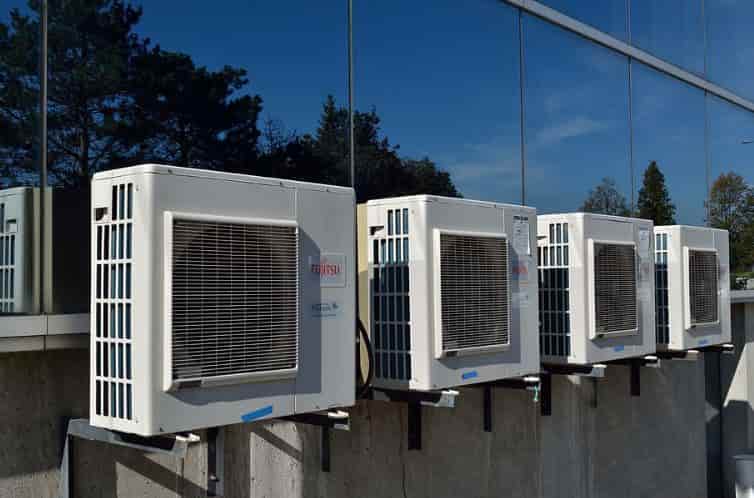
It operated on vapor-compression refrigeration and comes in a variety of sizes, from compact units that can be used in cars or small rooms to enormous units that can cool huge buildings.
The cooling and dehumidification of spaces with heat-generating electronics, such as computer servers and power amplifiers, is another use for air conditioning systems. It is also used in areas that contain fragile items like artwork.
As of 2018, the International Energy Agency (IEA) reported that 1.6 billion air conditioners were installed in buildings, accounting for 20% of global electricity consumption. By 2050, that figure should rise to 5.6 billion.
Now, let’s discuss the main parts of the air conditioner.
You might like: Types of Heat Exchangers & Their Application
Components of Air Conditioner System
The parts of the commercial air conditioner are explained below:
#1 Compressor
The compressor is the system’s engine because it works with a fluid that easily converts gas to liquid. The compressor converts low-pressure gas into high-pressure, which commonly has a high temperature.
In order for it to function, a produced energized gas reduces the gap regions between molecules. The compressor releases this energized gas, also referred to as a refrigerant, which then enters the condenser.
#2 Condenser
The outdoor component of a heat pump or air conditioner is called a condenser, and depending on the season, it either releases or absorbs heat. Condensers for heat pumps and split air conditioners share the same fundamental components.
#3 Condenser Coil
As the high-pressure gas is converted into a liquid, the condenser coil contains a fan that cools the gas and converts it into a liquid form. The obtained liquid is utilized by the evaporator to perform the work. You’ll find the compressor and condenser outside of the home.
#4 Thermostat
The thermostat controls the heat energy inside and outside of an air conditioning system while maintaining the temperature of the system. A thermostat’s setting options include manual and automatic, depending on the design.
#5 Evaporator
Evaporators are part of the HVAC system that is located inside the home close to the boiler or furnace. They are linked to the condenser by a very thin pipe.
In the air conditioner, the high-pressure gas is changed into a low-pressure liquid. Due to the pressure drop, the liquid then turns into a gas. It is the fluid or refrigerant that cools and removes heat from the system.
The evaporator condenses the fluid into a gas, which is then compressed by the compressor. Everything happens in a cyclical way.
#6 Air Handler and Blowing Unit
These parts of the air conditioner work together to circulate cool air throughout the room and draw air to the evaporator. A duct system allows air to flow freely throughout the room.
#7 Fan
The indoor air handler of an AC unit is connected to the fan. The warm air in your house will be returned to the condenser by the fan. The recirculated air will return to the air handler, where it will be transformed into cool air and distributed throughout your duct and vent system all over your home.
#8 Filter
The heating and cooling system in your home uses HVAC filters, which have a crucial job to do. It removes tiny particles from the air that you and your family breathe, such as dust, pollen, pet dander, and other impurities. In order to keep them from being circulated again throughout your home, these particles are captured in the filter.
Below is a detailed diagram of an air conditioning system:
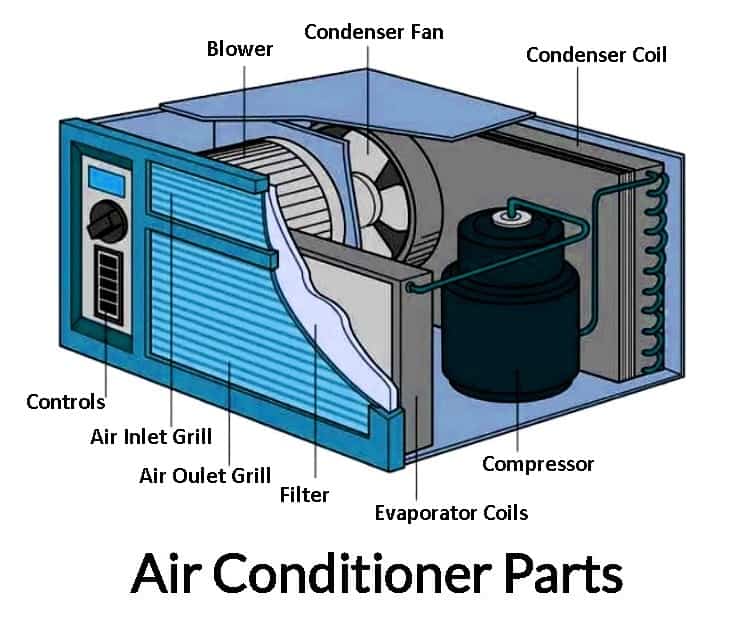
You might like: Different Types of Fluid Flow Explained
Working of Air Conditioner
Now that you have a basic understanding of an air conditioner’s parts. So let’s dive a little deeper and explain how the entire process functions.
The thermostat monitors and regulates the indoor air temperature and is typically mounted on a wall in the middle of the house. As soon as the thermostat detects that the air temperature needs to be lowered, it signals the air conditioning system components both inside and outside the home to begin working.
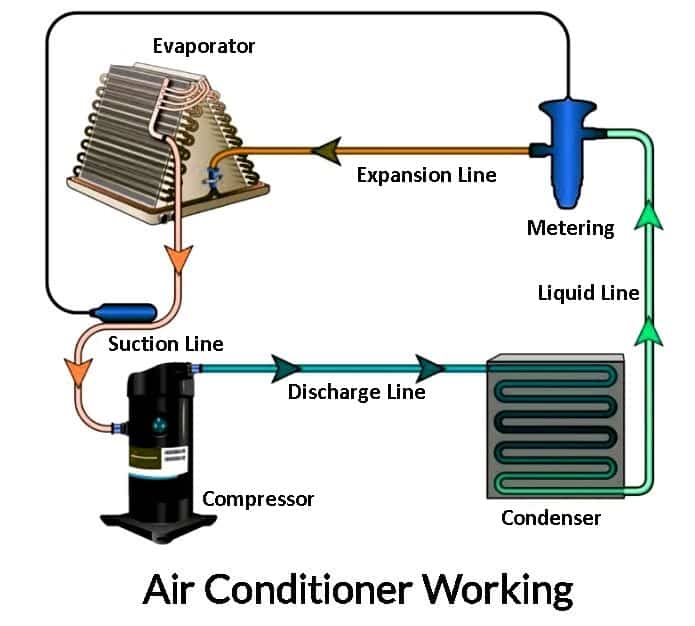
The fan on the indoor unit pulls hot air through return air ducts from the home. This air travels through filters that collect dust, lint, and other airborne particles. The heated indoor air that has been filtered then travels over a cold evaporator coil.
By absorbing heat from the indoor air and converting it to gas, the liquid refrigerant inside the evaporator coil cools the air passing over it. The blower fan of the indoor unit then circulates the cooled air back through the ductwork of the house and into the different living spaces.
Through a copper tube, the refrigerant gas leaves the house and enters the compressor of the outdoor air conditioner. Consider the compressor to be a large electric pump. The compressor pressurizes the refrigerant gas before delivering it to the condenser coil of the outdoor unit.
The condenser coil has the ability to absorb and release heat from the house thanks to a large fan that forces outside air through it. The refrigerant is changed back into a liquid during this process. After that, it returns to the indoor unit via a copper tube and passes through an expansion device to control the flow of refrigerant into the evaporator coil.
As the refrigerant cools, more heat is absorbed from the air, and the cycle repeats.
You might like: What is Compound Steam Engine?
Functions of Air Conditioning System
The following are some of the primary purposes of an air conditioning system in a modern home:
- The primary function of air conditioning is to provide a pleasant climate for humans.
- To lower the temperature of electrical devices, a unique type of conditioning system is used.
- It regulates a room’s humidity since 30 to 65% is allowed and the temperature should be between 20 and 26 degrees Celsius.
- The air conditioning system affects the room air to keep people comfortable while not interfering with their productivity.
- Temperature, pressure, and humidity all affect the air’s quality. The air pressure does not change.
- An air conditioning system may be used for heating, dehumidification, cooling, and humidification.
Classification of Air Conditioner System
The air conditioning systems are classified in order to distinguish one type from another. This serves as the base for selecting the best air conditioning system for the building’s needs. There are three subcategories of air conditioners, including:
Classification based on major function:
- Comfort air conditioning e.g. hotels, homes, offices, etc.
- Commercial air conditioning e.g. malls, supermarkets, etc.
- Industrial air-conditioning e.g. processing, laboratories, etc.
Classification based on the season in the year:
- The summer air conditioner is a cooling device that controls all four atmospheric conditions for the comfort of the summer months.
- The purpose of a winter air conditioner is to provide warmth and comfort during the cold months.
- Usually, a year-round air conditioner consists of a heating and cooling system which is controlled automatically, making it able to maintain a comfortable indoor temperature in any weather condition throughout the year.
You might like: Summer, Winter, and Year-Round Air Conditioning System
Types of Air Conditioners
The different types of air conditioning systems are listed below:
#1 Central Air Conditioner
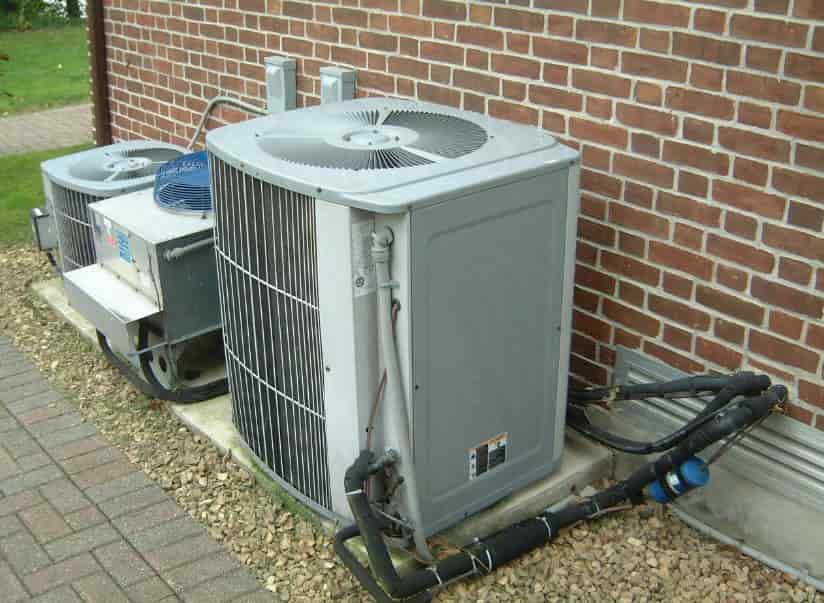
The most popular kind of cooling system is central air conditioning. Due to its effective cooling, it is most frequently used in larger homes. Cool air is circulated by the air conditioning system through supply and return ducts.
Supply ducts and registers that are located on the walls or floors provide the air that enters the home. When the air has warmed up, it returns to the supply registers and ducts where it is transferred back to the air conditioner.
These types of air conditioning system installation demand careful consideration, preparation, and planning. The system’s functionality depends on its size; if the system is installed in the incorrect size, even if it is effective, the utility costs will be higher than they should be.
#2 Ductless or Mini-Split Air Conditioner
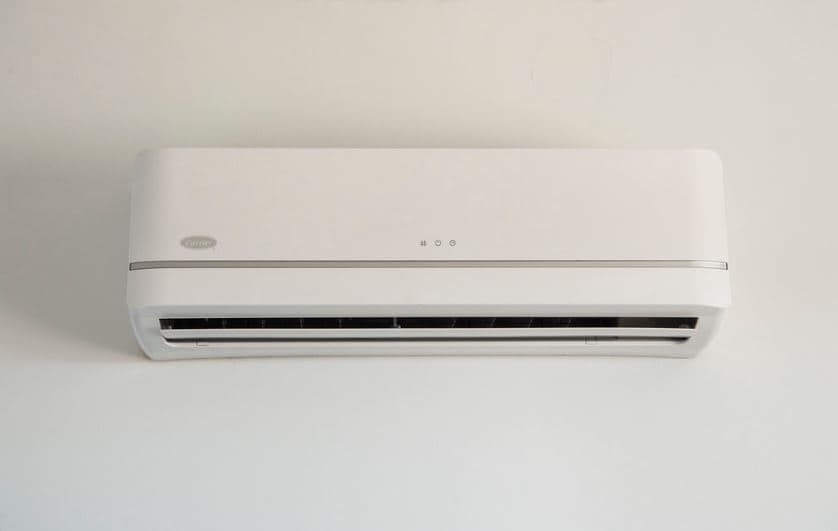
Mini-split ductless air conditioners are also popular, but they have been modified with new components. Both an indoor handling unit and an outdoor compressor/condenser are present in these systems, just like in central air conditioning.
These types of air conditioning systems allow for up to four indoor handling units, making them effective at cooling individual rooms. This connects the handling unit to the outdoor unit. Furthermore, each handling unit has its own thermostat, allowing it to operate at different temperatures.
#3 Window Air Conditioner
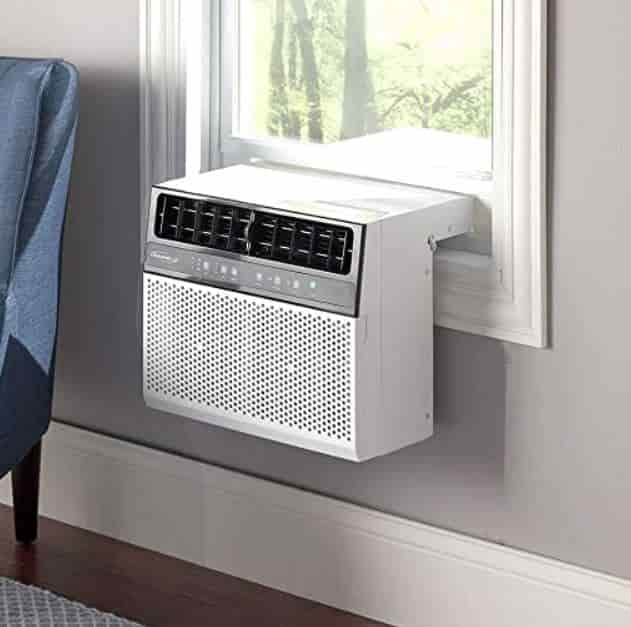
A window air conditioner is a small system that works well for cooling a single room. The system is installed in a window and is also referred to as a unitary unit.
When the air conditioning system is in operation, warm air is blown out the back while cool air is blown out the front. It’s ideal for people who live in small rooms but isn’t ideal for larger homes because it doesn’t effectively cool in those conditions.
#4 Portable Air Conditioner
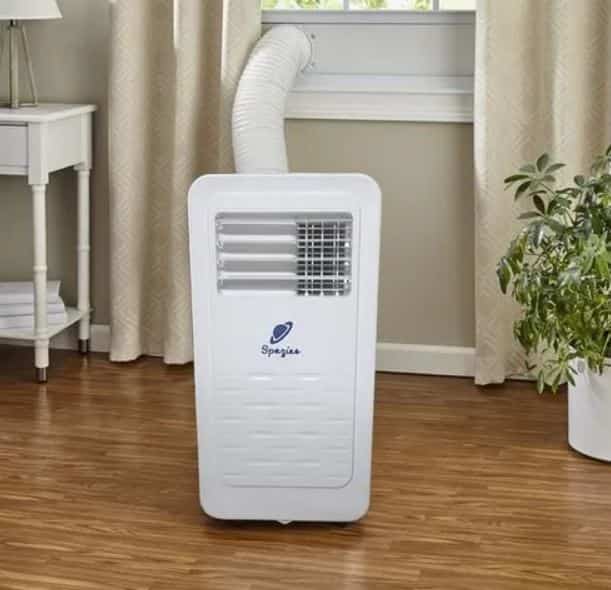
In this unit, the air is taken from the room and cooled, then it is sent back. Also, it vents warm air outside through an exhaust hose that is mounted in a window. These kinds of systems are made to cool just one room, just like window air conditioners. They are cost-effective, adaptable, and simple to install. Because of its portability, it is even more ideal.
#5 Geothermal Heating and Cooling
Geothermal energy is durable, energy-efficient, and sustainable. It is possible to perform these cooling and heating processes because the ground temperature is always 55 degrees. No matter how warm or cold the weather is, it remains constant.
Utilizing geothermal technology, heat is drawn from the earth and used inside the home. A geothermal coil (loops or wells) is installed deep into the ground, which cools and heats the house and then returns it to the earth.
#6 Hybrid Air Conditioning
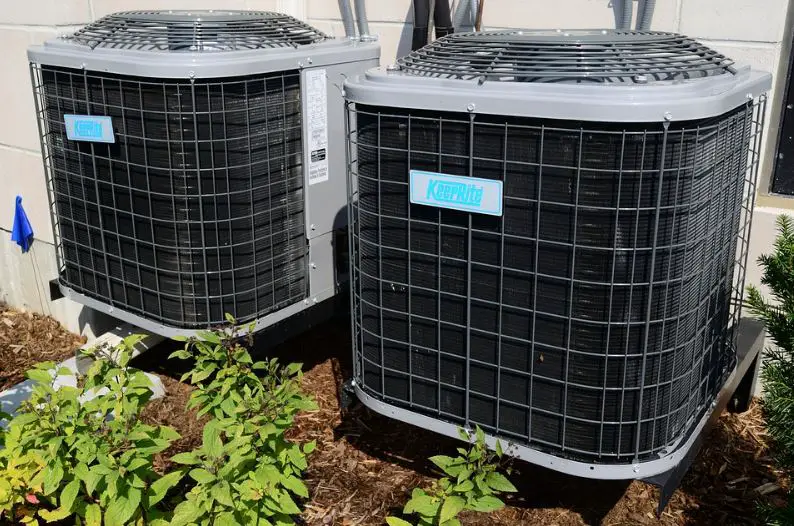
Hybrid air conditioners have heat pumps that can be powered by electricity or fossil fuel combustion. Manufacturers choose an appropriate energy source with care in order to save money and energy.
The system operates normally in the summer, drawing heat from the inside and distributing it outside. In the winter, it works in reverse, drawing heat from the outside and discharging it into the house.
The hybrid pump system operates in accordance with the second law of thermodynamics, which states that heat is transferred from a hot to a cold object.
As a result, when the refrigerant temperature falls below the outside temperature, heat from the outside environment is transferred to the system heat pump coils and into the refrigerant. As a result of the extracted heat, the air in the room is warm and conditioned.
You might like: What is Thermodynamics? 3 Laws of Thermodynamics
Advantages of Air Conditioning System
Air conditioning provides health benefits in addition to comfort. Let’s take a look at why air conditioning is good for you.
#1 Reduces the Possibility Of an Asthma Attack
Most people are unaware that air conditioning helps filter and disinfect the air we breathe and can even reduce asthma attacks. An air conditioner can reduce the amount of pollen, mildew, mold, dust mites, and other airborne allergens that can cause asthma.
Exposure to mold is one of the primary factors that is linked to allergic reactions, asthma symptoms, and other respiratory complications. Your AC filters need to be changed more frequently, at least once every two weeks.
#2 It Saves Life
According to the Environmental Protection Agency’s most recent studies, more than 9,000 Americans per year pass away from heat-related causes. Heat is a factor in many more deaths, though it is not the primary cause.
With an effective air conditioner, illnesses and even deaths brought on by the heat can be avoided in homes and workplaces. Your air conditioner really could save your life!
#3 Better Air Quality
Another reason to relax is to install air conditioning. Because of poor ventilation and overheating, the indoor air can become contaminated with dust and bacteria, threatening your health.
Coughs, colds, headaches, and fatigue are all possible symptoms. Air conditioners can greatly enhance indoor air quality and promote a much healthier environment. This is due to the fact that they have the ability to flitter out pollen, dust, and other environmental allergens.
#4 Controls Humidity
When humidity levels are high, hot summer days become uncomfortable. High humidity is nothing new to Australians, but it is having a negative impact on their health. A humidity of between 30% and 50% is ideal.
While there is little you can do about outdoor humidity, an air conditioner can significantly lower indoor humidity. It is nearly impossible to use fans in hot and humid weather, even lying semi-naked is not effective.
Either you can spend your money on a dehumidifier or you can choose an air conditioner that has more advantages.
#5 Improves Sleep
This advantage of an air conditioner is crucial because sleep is crucial to both your physical and mental health. Due to the summer’s heat, it can be difficult to sleep, which can lead to a number of health issues. It has been established that an air conditioner can improve your ability to sleep.
It’s because your body needs to cool down before going to sleep because the heat in the room raises your core temperature. Here, an air conditioner can offer the perfect temperature for your body to cool off.
#6 Prevents Your Devices from Overheating
Your electrical appliances are also likely to suffer greatly from the heat and are also at risk for overheating, in addition to the effects on the human body and mind.
Heat can damage a variety of appliances, including toasters, microwaves, and cell phones. By choosing air conditioning services, you will be able to maintain not only your health but also the condition of your electrical equipment.
#7 Reduces Insects and Parasites
People are searching for any method, device, or magic spell to stop mosquito bites, invasions, and house flies. Few people are aware of this, but your air conditioning lowers the number of bugs and parasites. These troublesome creatures are not only a nuisance to deal with, but they also carry diseases.
Disadvantages of Air Conditioning System
Despite the fact that air conditioning has many advantages, there are some drawbacks as well.
#1 High Energy Bill
The average household uses 40% of its energy for heating and cooling. The cost of energy will undoubtedly rise as an air conditioner uses electricity to keep a comfortable temperature. You can purchase an energy-efficient air conditioner.
#2 Causes Skin Dryness
Since the air conditioning system removes humidity from the air, if you spend a lot of time in one, your skin will start to lose moisture. It might make your skin sensitive and dry. It may cause skin irritation and mucous membrane dryness. Whenever you start to experience these issues, use moisturizer.
#3 Negative Environmental Impacts
Although air conditioners make our lives more comfortable, it is unfortunate that they also pollute the environment and release harmful gases. A few studies predict that by 2050, air conditioning will contribute to about 25% of global warming.
#4 Increases Flu, Cold, And Sinus Symptoms
The symptoms of a common cold or flu, such as a sore throat, fever, nasal congestion, and cough, can be made worse by the air conditioning system. It is because an air conditioner blows dry air into the space that dries out membranes and causes throat irritation.
#5 Respiratory Complications
The benefits of having an air conditioner are undeniable, as it reduces the number of allergens in the air. But over time, the AC filter becomes clogged and dirty.
If the filter isn’t cleaned at least once every two weeks, it can spread dangerous dust and other particles and result in breathing issues. It is crucial to realize that by routinely cleaning the filters, the majority of health risks related to using an air conditioner can be minimized.
Conclusion
That’s it. Thanks for reading. I hope I have covered everything about the “Air Conditioning System” It would be helpful if you could let me know if there was anything I missed or if you have any doubts about anything I wrote.
Please share this article with your friends if you find it interesting.
Want free PDFs direct to your inbox? Then subscribe to our newsletter.
Download PDF of this article:
You might like to read more in our blog:
- Types of Boiler Mountings and Accessories
- List of Different Types of Thermodynamic Cycles
- Types of Cooling System In Automobile Engines
External Link:
Frequently Asked Questions
Through the conversion of liquid refrigerant into gas in the evaporator coil, heat from the indoor air is absorbed into the refrigerant, which cools the air as it passes over the coil. The cold air is then circulated back through the ductwork of the house and into the various living areas by the blower fan of the indoor unit.
A typical air conditioner consists of four main components: the evaporator coil, the compressor, the condenser coil, and the expansion valve. Every part of your central air conditioner contributes in a different way to the comfort of cooling your home.
When selecting an AC system, there are 4 key considerations to make: efficiency & cost, comfort & practicality, taking control of your AC system, and reliability.
Every month or during the cooling season, clean or replace the filter(s) in your air conditioning system. If your air conditioner is constantly used or is subject to dusty conditions, or if you have pets with fur, filters will need more frequent replacement.
hi, i”m hari
Hey there